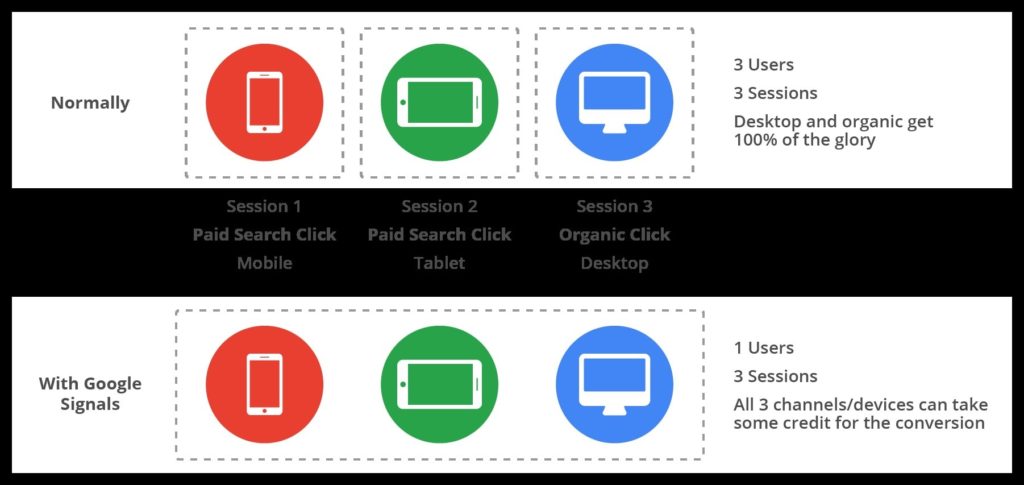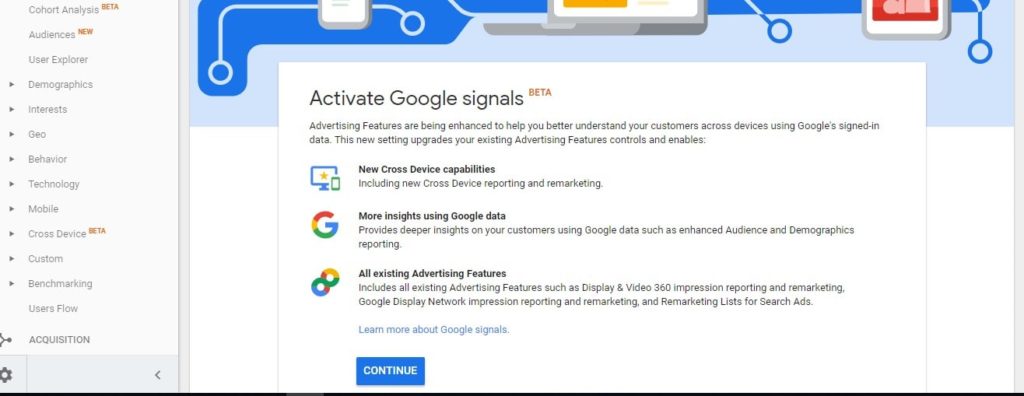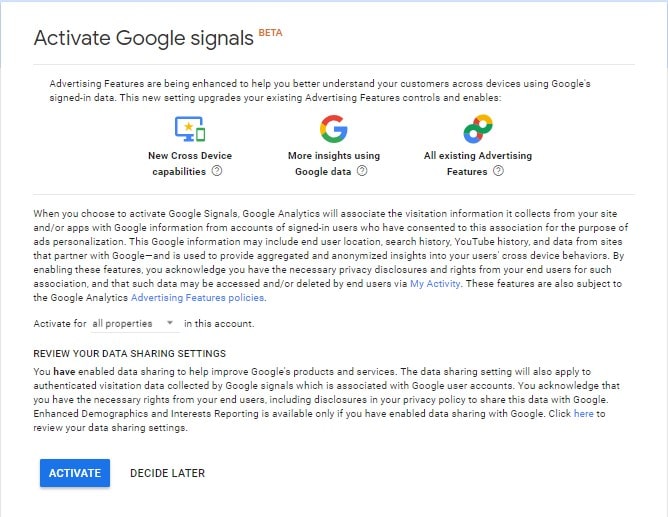Google Signals Beta has launched – Your customer journey just got a lot clearer!
Google analytics has just rolled out Google Signals in its Beta version.
And boy are we excited.
We all know that customers are using more and more varied devices during their online journey. For example, you might have checked out a website on your mobile during the day, and then jumped on a desktop or tablet later that night to compare your options and make a purchase.
Previously, it has been difficult for marketers to get a clear picture of the journey that a visitor takes across mobile, tablets and desktop. There hasn’t been a means to track one user across multiple devices, as data has been session based, rather than user based.
But now with Google signals’ cross-device features, we are able to track this journey. This much-anticipated release gives us a more complete view of the value of our marketing activity across devices and the ensuing insights that follow.
How does Google Signals collect cross-device data?
Google is observing the behaviour of users who are signed into one of their Google accounts (for example, Gmail, Google+, Youtube) and have Ads Personalisation turned on. It will look at logins and device-types for all users, including those who have converted on site. From the aggregated data, Google Analytics models the cross device behaviour for your whole user base.
What insights will Google Signals provide?
Imagine a digital advertising campaign.
Analytics knows which device a user was on for the initial ad click and the subsequent conversion. It now also knows what other interactions the user undertook with the same advertiser in between the ad click and conversion.
For example, a user might click on an ad while on a mobile, click a second ad while on a tablet and then complete the conversion on a desktop after typing in the URL directly. You can now discover if this is a common pattern for many users, and then decide to prioritise mobile ad campaigns to help them plan their purchase.

Instead of seeing three separate sessions (one on desktop, tablet, and mobile) you’ll be able to see when users visited your website from all three different devices.
There are a lot of reasons for publishers and marketers to be excited!
By understanding device interactions as part of a broader customer experience, you can make more informed product and marketing decisions. Imagine being able to:
- Accurately report on the number of users, instead of devices
- Help focus marketing efforts and spend on the most valuable users
- Optimise user experience for the whole customer journey across devices
- Optimise ad spend
- Offer highly relevant, hyper targeted ads
We’re already hatching our own plans on how to use the data.
1. Tracking which device drives the most conversions:
At Alpha Digital, we love to optimise our clients spend. That’s why we are going to use Google Signals to keep a close watch on which devices produce higher returns on their advertising and SEO investments.
Google Signals now collects the goal value, goal conversion rate, number of goal completions and goal value per user on each device. Consider the value of knowing whether mobile, desktop or tablet is driving more conversions. Even better, we can also tell which device pathway (e.g. mobile to desktop) converts the most.
Imagine knowing that you should prioritise advertising spend on mobile because it drives the most revenue for you. Or easily identifying an underperforming device and delving into why its digital experience is not delivering the results you expect. Traditionally, mobile and tablet have been under-reported because of lack of visibility. You can now prioritise spend on those devices because you know what they’re actually worth to you.
2. Better understanding customer loyalty:
We will now also be able to track a customer spend across devices.
Imagine you want to share a promotion with your most loyal, highest spending customers. Now you can accurately measure how much money they have spent across devices and create a more accurate audience list.
A customer who has spent $1000 on a desktop is just as valuable as some one who has spent $500 on mobile and $500 on desktop, right
3. Hyper-targeted remarketing campaigns:
In addition to targeting highly specific audiences, we can now also reach them based on how many times they have visited your website across multiple devices.
The customer journey is no longer linear, so the challenge that we all face today is sending the right message to the customer at the right time. With cross-device capabilities, we can see when and where customers are thinking about buying, versus being ready to make a purchase. Our decisions about when and where to place brand messages versus product messages then become a lot more informed.
How to set up Google Signals:
Google has already published an easy-to-follow list of steps for activating Google Signals.
You will also be able to see the activation prompts below under Cross Device Beta in the audience segment of Google Analytics.


Keep in mind that you cannot apply segments to the cross-device reports currently, and they are subject to sampling. The reports are sampled when the data for your date range exceeds >250K sessions. This process helps to ensure that no one can infer the identity of an individual user.
If your data is withheld from your report because it doesn’t meet the threshold, try increase the date range and remove any filters to increase the volume of your data.
Are you thinking about how you can also take advantage of Google Signals? Get in touch with one of our digital marketing experts today.